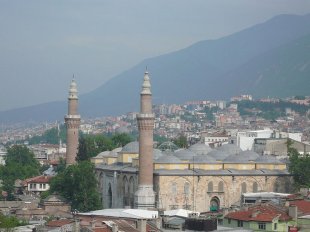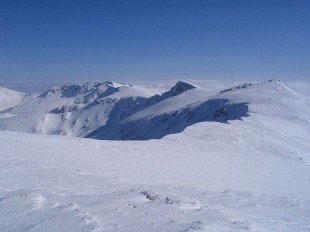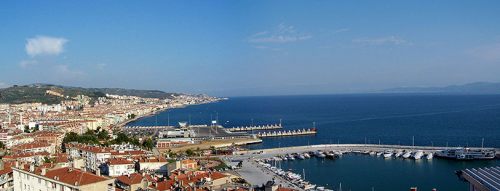|
|
| |
TURKEY
BURSA
Bursa is a city in the Asian part of Marmara Region, Turkey. It lies in the northwestern part of Turkey near the Sea of Marmara, about 20 km inland. Bursa was the first major city the Ottomans, who started as a small emirate in the countryside just east of Bursa, had taken control of. As such, it served as the first capital city of the Ottoman Empire, from 1326, when it was captured from the Byzantines, to 1365. As such most of the historic sites date back to this early period of Ottaman empire. Today it is the fourth largest city in Turkey as is very popular with tourists. Close to Bursa is one of the main winter sports centres of Turkey. It is located on Uludağ, one of the highest mountains in the Turkey.
 Bursa Grand Mosque
Photo: Beñat Irasuegi
Bursa Grand Mosque
Bursa Grand Mosque or Ulu Camii is the largest mosque in Bursa and a landmark of early Ottoman architecture. It was built in Seljuk style and ordered by the Ottoman Sultan Bayezid I. The mosque has 20 domes and 2 minarets. The horizontally spacious and dimly lit interior is designed to feel peaceful and contemplative. The subdivisions of space formed by multiple domes and pillars create a sense of privacy and even intimacy. Inside the mosque there are 192 monumental wall inscriptions written by the famous Ottoman calligraphers of that period and is one of the greatest examples of Islamic calligraphy.
 Entrance with mocárabe half-dome,
the Yeşil Cami (Green mosque) of Bursa
Photo: Georges Jansoone
Yeşil Mosque
Yeşil Mosque is part of a larger complex located on the east side of Bursa, Turkey, the former capital of the Ottoman Turks before they captured Constantinople in 1453. The complex consists of a mosque, türbe, madrasah, kitchen and bath. The mosque is built out of sandstone and clad with marble panels. Flower designs and scriptures carved in marble frame the entry and the windows, with a different design featured in tympana of every window. The iron parts used on the door, windows and cupboards of the mosque are proof of excellent workmanship.
 Top of the Uludağ range, Basra province
Photo: BicounetUludağ
Uludağ is a mountain in Bursa Province, Turkey, with an altitude of 2,543 m. It is a popular center for winter sports such as skiing, and a national park of rich flora and fauna. Summer activities, such as trekking and camping, also are popular. The highest area in western Anatolia, Uludağ is easily ascended by car or cable-car. The cable-car ascends from Bursa and has an intermediate stop in the alpine meadows of Kadiyayla at about 1,200 m (3,937 ft) elevation. It ends at Sarialan at about 1,630 m (5,348 ft).
 View of Mudanya from above
Photo: DarwinekMudanya
Mudanya is a town and district of Bursa Province in the Marmara region of Turkey. It is located on the Gulf of Gemlik, part of the south coast of the Sea of Marmara. The town produces olive oil and there is a pier used by local fishing and cargo boats. The town was the signing place of the Armistice of Mudanya between Turkey, Italy, France and Britain on October 11, 1922, following the Turkish War of Independence.
 Emir Sultan Mosque in Bursa
Photo:
Aytacatlas usa
Emir Sultan Mosque
Emir Sultan Mosque is a mosque in Bursa, Turkey. First built in the 14th century, it was rebuilt in 1804 upon the orders of the Ottoman Sultan Selim III, and re-built again in 1868. Although the materials and the location were maintained, the style was adjusted to reflect the baroque design that came into fashion in the Ottoman Empire during the 19th century. The mosque and mausoleum stand on opposite sides of a large courtyard with large basin at the entrance. The courtyard entrances are on the east and the west and the mosque and mausoleum are accessed through the courtyard.
|
|
|
Festivals & Events
Ramadan
People, neighbours, relatives and friends pay visits and go to see each other. Young people kiss their parents’ hands and receive best wishes and blessings from them. It is a tradition to give money or little gifts to those childreen who kiss one’s hands. Candies are served to visitors during Ramadan. That is why Ramadan is also called the “Sugar Festival”.
Feast of the Sacrifice
This festival takes place in Islam as a memory of the story in which a ram fell from the sky just at the moment when the Prophet Abraham was about to sacrifice his son to God.
Hıdrellez
Hıdrellez, is one of the seasonal festivals of all Turkish world. Hıdrellez Day, which is known as Ruz-ı Hızır (day of Hızır), is celebrated as the day on which Prophets Hızır and Ilyas met with each other on earth. The words Hızır and İlyas have since fused together pronounced as Hıdrellez. Hıdrellez Day falls on May 6 in the Gregorian calendar and April 23 in the Julian calendar, also known as the “Rumi” calendar.
Nevruz
The word Nevruz is of Persian origin and is a combination of the words “nev” (new) and “ruz” (day), meaning new day. According to the old Persian calendar, it is the first day of the year and regarded as the start of spring, when the sun enters the house of Aries.
Victory Festival, (August 30)
On this day in 1922, the fifth day of the big attack against the invading Greek Armies, the Dumlupinar Battle under the command of Mustafa Kemal was won and determined the result of the Independence War. This big attack ended in Izmir with the defeat of the Greeks on September 9.
The Republic Festival, October 29
This is the anniversary of the declaration of the Turkish Republic by the Turkish Grand National Assembly in 1923.
National Sovereignty and Children's Day,
April 23
On this date in 1920, during the War of Independence, the Turkish Grand National Assembly was established in Ankara by Mustafa Kemal and laid down the foundations of a new independent state from the ashes of the Ottoman Empire. The founder of the Turkish Republic, Mustafa Kemal Atatürk, dedicated April 23 to the children of the country to emphasize that they are the future of the new nation. This is the world's first and only holiday for children.
Commemoration of Atatürk and Youth and Sports Day,
May 19
On this date in 1919, Mustafa Kemal arrived in Anatolia at the Black Sea Port of Samsun which marks the beginning of the War of Independence. The week including this holiday has been celebrated as "Youth Week" in Turkey since 1983.
Seker Bayrami
This three day festival comes after an entire month of "absolute" fasting during Ramadan in which Qur'an was revealed.
Kurban Bayrami
This four day festival falls on the tenth day of the last month of the Muslim year and marks the completion of the course of Hajj (pilgrimage to Mecca). Sacrificial animals are slaughtered and their meat distributed among relatives, neighbors and the poor on this occasion. The slaughtering of animals is a symbolic expression whereby a Muslim express his readniess to lay down his own life and everything he owes for the sake of God.
|
|
|